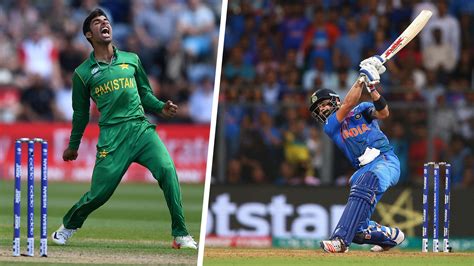Explore how weather impacts cricket match outcomes, from humidity and pitch behavior to rain delays and wind influences on strategies.Cricket is a game deeply influenced by a myriad of external factors, none more significant than the weather. From the sweltering heat to the brisk winds, various meteorological conditions can dramatically alter match dynamics and outcomes. This article delves into the intricate relationship between weather and cricket, highlighting how humidity impacts player performance, how different weather patterns affect pitch behavior, and what happens during unexpected rain delays. Whether you’re a passionate player, a dedicated fan, or simply curious about the nuances of the game, understanding these weather-related factors can enhance your appreciation of cricket. Join us as we explore how the climate can become both an adversary and an ally on the field, ultimately shaping match strategies and outcomes.
Understanding How Weather Influences Cricket Match Outcomes
Weather plays a crucial role in the outcome of a cricket match, often changing the dynamics on the field significantly. Several factors come into play when considering how weather conditions affect the performance of players and the behavior of the pitch. The conditions can influence decisions made by captains and teams, the strategies they employ, and ultimately the result of the match.
Here are some of the primary weather conditions and their effects on cricket:
| Weather Condition | Effect on Match |
|---|---|
| Sunshine | Hard pitches tend to be good for batting, as the ball comes onto the bat nicely. |
| Overcast | The ball can swing more, giving bowlers an advantage. |
| Humidity | Can lead to a softer ball, affecting bounce and seam movement. |
| Rain | Interruptions lead to a revised target (Duckworth-Lewis system) and can disrupt team momentum. |
| Wind | Can aid bowlers in swinging the ball and affect how batsmen approach their innings. |
Understanding how weather impacts the game not only helps teams prepare better but also allows fans to appreciate the nuances of the sport. Coaches often factor in these weather conditions during gameplay, making real-time decisions that can sway the match in their favor.
The Impact of Humidity on Players’ Performance
Humidity is one of the critical weather conditions that can significantly influence the performance of cricket players during a match. When the air is humid, it affects both the players’ physical exertion and the condition of the cricket ball.
Humid conditions can lead to increased fatigue among players, as the body struggles to regulate temperature and sweat effectively. This can result in reduced stamina and focus, potentially impacting their performance in critical moments of the game. In particular, bowlers may find it challenging to maintain their rhythm, while batsmen could struggle with their timing as the grip of the bat may change due to sweat.
Moreover, how weather impacts humidity levels can also alter the behavior of the cricket ball. A humid atmosphere can cause the ball to seam more due to the moisture in the air, benefiting fast bowlers. On the other hand, spinners might struggle to get the necessary turn and grip on a wet pitch, which can lead to higher scoring rates for batsmen.
The interplay between humidity and player performance is complex and can determine match outcomes. Teams must adapt their strategies according to the prevailing humidity levels to maximize their chances of success on the field.
How Weather Conditions Affect Pitch Behavior
The cricket pitch is often regarded as the most crucial element in the game, as it significantly influences the flow and outcome of a match. How weather conditions interact with the pitch can alter its characteristics, ultimately impacting player performance and match strategies.
One of the most notable weather-related factors is moisture. Rain before a match or during breaks can lead to a damp pitch, which typically assists seam bowlers. The additional moisture allows the ball to move more off the surface, creating challenging conditions for batsmen. Conversely, when the ground dries out under the sun, the pitch can harden, benefiting stroke play and making batting easier.
Temperature also plays a vital role. In hotter conditions, the pitch can crack and deteriorate quickly, which may cause it to behave unpredictably. Spinners often exploit these cracks, making it difficult for batsmen to play straight. Lower temperatures can help maintain more consistent pitch conditions, allowing players to better predict ball behavior.
Wind conditions impact the rate of evaporation on the pitch. Strong winds can dry out the surface quickly, altering its behavior during the course of a match. It is essential for teams to adapt their strategies based on the pitch conditions influenced by wind and temperature.
It is essential to consider artificial factors. Groundskeepers may employ water or rolling techniques to prepare pitches favoring either batsmen or bowlers, depending on the forecasted weather. This human intervention, combined with natural weather conditions, creates an ever-changing landscape that cricket teams must navigate.
Understanding how weather conditions affect pitch behavior is integral for teams aiming to gain an advantage during matches. Coaches and players must analyze weather forecasts closely to adapt their strategies accordingly, as pitch dynamics can shift significantly throughout a game due to weather influences.
Analyzing Rain Delays and Their Resulting Effects
Rain delays can profoundly impact the dynamics of a cricket match. When rain interrupts play, teams often need to adjust their strategies significantly. The how weather influences these outcomes is crucial for understanding the game’s flow.
First and foremost, rain delays disrupt a team’s momentum. A team that is performing well may find that a break in play can diminish their concentration and rhythm, while the opposing team may regroup and reassess their game plan. This shift can lead to fluctuations in performance levels when the match resumes.
| Effect of Rain Delay | Short-term Impact | Long-term Impact |
|---|---|---|
| Player Recovery | Gives tired players a rest | Can affect their performance in later matches |
| Game Strategy | Opportunity to modify tactics | Long-term team strategy may adapt |
| Field and Pitch Conditions | Can change the game dynamics | Makes pitch behavior unpredictable |
Moreover, rain delays often lead to changes in the format of the match. For instance, if rain significantly cuts down the number of overs, officials may revert to using the Duckworth-Lewis-Stern (DLS) method to calculate target scores. This method alters the game’s outcome based on available resources for each team, further emphasizing the influence of how weather can sway match results.
Teams must adapt quickly to the changing circumstances presented by rain delays, emphasizing the need for a strategic mindset that accounts for the unpredictable nature of cricket affected by the how weather conditions.
The Role of Wind in Shaping Cricket Strategies
Wind is often an overlooked factor in cricket, yet it plays a significant role in shaping on-field strategies for both batsmen and bowlers. Understanding how wind interacts with the ball can ultimately influence match outcomes, making it crucial for teams to adapt their tactics accordingly.
For bowlers, wind direction can greatly affect how the ball behaves in the air. A strong headwind can slow down the ball, causing it to lose momentum, while a tailwind can give the bowler an extra push, making the ball travel faster. This can lead to changes in bowling techniques, such as adjusting the angle of delivery or changing the length of the bowl to exploit wind conditions.
Batsmen also need to consider wind when preparing to face deliveries. A gusty breeze can lead to unpredictable ball movement, especially with aerial shots. Batsmen might choose to play more conservatively, focusing on ground strokes rather than risking out-of-control aerial shots that could be affected by sudden gusts.
Furthermore, teams may adjust their field placements based on wind patterns. For example, if the wind is blowing in a particular direction, fielders might be positioned strategically to catch balls that are likely to carry due to the wind. Similarly, captains may consider which bowlers to utilize based on how well they can control the ball under varying wind conditions.
how weather, specifically wind, affects not just the cricket ball but also the players’ strategies is vital for success on the pitch. By analyzing wind conditions and making necessary adjustments, teams can leverage this natural element to their advantage, ultimately influencing the outcome of the match.
Frequently Asked Questions
What are the primary weather conditions that can impact a cricket match?
The primary weather conditions that can impact a cricket match include temperature, humidity, wind speed, and the presence of rain or overcast skies.
How does high humidity affect players during a match?
High humidity can lead to dehydration and fatigue in players, affecting their performance and concentration levels on the field.
What role does temperature play in determining match conditions?
Temperature influences the behavior of the ball and pitch, with higher temperatures often causing the pitch to dry out and crack, while cooler temperatures can lead to more favorable swing bowling conditions.
Can wind conditions influence the outcome of a cricket match?
Yes, strong winds can affect the trajectory of the ball, impacting both batting and bowling, and can also contribute to difficulty in fielding.
How does rain affect the rules and outcome of a cricket match?
Rain can lead to delays, and if the match is interrupted, the Duckworth-Lewis-Stern (DLS) method is often used to adjust targets and results based on the overs lost.
What is the significance of overcast conditions in cricket?
Overcast conditions can enhance swing bowling, as the moisture in the air allows the ball to move more in the air, which can give bowlers a significant advantage.
How can teams prepare for adverse weather conditions before a match?
Teams can prepare by studying weather forecasts, having contingency plans for rain, adjusting training and fitness regimes based on expected conditions, and ensuring they have proper equipment to handle varied weather.









